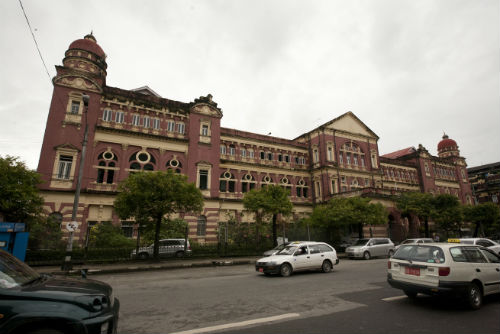|
Excerpted from an article by Jane Perlez that appeared in
The New York Times last December.
In Myanmar (formerly Burma) there is a race on to salvage once-grand colonial buildings – banks flanked by Corinthian pillars, courthouses adorned with limestone lions, and shipping headquarters decorated with dark wood and brass fixtures – before they collapse of decay.

Once the Rangoon High Court.
“The conservation of the buildings, laid out on a grid of broad avenues designed by British engineers, would make the city a star attraction of Southeast Asia,” says Thant Myint-U, the head of the Yangon Heritage Trust.
“The future is all about cities,” adds Thant Myint-U, who is trying to convince the government that the old has value and must be preserved. “Having a beautiful downtown will bring investment and give us an advantage over cities like Chennai and Kuala Lumpur.”
During the colonial period, Rangoon served as the capital of Burma. The city had its own particular ethos. In 2005, the government moved from Yangon (formerly Rangoon) to a new capital, Naypyidaw, leaving empty many buildings that had at least been occupied, if not maintained.
Among the abandoned structures, the Secretariat, a vast Victorian-era complex arranged around lush gardens that had served as the heart of the government, fell on hard times. The red domed buildings now need an estimated $100 million in repairs.
The Yangon Heritage Trust has won some victories. The group objected to plans for a major new building of more than 20 stories in the historic downtown area. The government ruled in favour of the Trust, and now there is an informal agreement that new structures downtown will not rise higher than six stories.
There is, however, no legal framework for protection of the buildings, and no discussion on how to protect the people who have been living in hallways, towers and hidden backrooms (of such buildings). The Trust hopes to change that with a master plan that would sort out legal ownership, designate renovation projects, and deal with traffic and sanitation by the end of 2015, said Thant Myint-U, the grandson of the former United Nations Secretary-General, U Thant, and a historian who has written books on Myanmar.
At the heart of the plan will be the idea that downtown Yangon should retain its vibrancy, rather than become another sanitised zone that appeals to well-to-do tourists impressed by expensive hotels and tony cafes, Thant Myint-U said. To preserve a sense of authenticity, he said, there will be efforts to keep residents in some of the buildings, perhaps with subsidised rents, and to limit the number of big, impersonal international hotels that attract foreign visitors but are off-limits to most locals.
The distinctive charm of the teetering colonial-era buildings lies in the street life around them: the bookstalls along Pansodan Street with paperbacks laid out on the sidewalk and vendors overseeing their wares from little plastic stools; the makeshift food booths selling small snakes in screw-top jars, watermelons the size of several footballs, bright orange papayas and emerald green limes.
In the parts of the city outside the historic zone, the skyline has changed little, though life has become more hectic after decades of somnolence under the military dictatorship. Migrants from the countryside squeeze into crowded apartments; hundreds of thousands more cars, a product of the growing economy, create some of the worst gridlock in Southeast Asia. Some historic buildings have been demolished, including the grandiose 1895 Government House resplendent with turrets and gables, and the house where the Chilean poet, Pablo Neruda, lived in the late 1920s as his country’s Consul.
|

